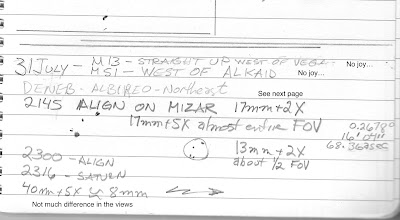After an unusually long four months of clouds and rain, the skies have been clearing over the past week. On the 29th, I got my first view of the globular cluster Messier 22. Last night and this morning, I revisited targets that had not been attainable a week ago because of the poor seeing despite nominally “clear” reports from weather websites. I also observed Messier 21, a globular cluster in northwest Sagittarius.
We amateurs speak of our “grab and go” instruments, smaller lightweight, that are easy to set up and transport. After borrowing three catadioptric telescopes weighing up to 65 lbs (30 kg)—and buying one of them—from the local club, portability was a consideration for me for all of my recent purchases. But “grab and go” does not work well for me. I like to do a lot of reading, planning, and arithmetic before I go out. And I prefer to be out for three or four hours, not just one. I got that opportunity. And last night’s work will allow me to plan better for my next viewing.
I started with the intent to find M13 the Hercules Cluster, M51 the Pinwheel Galaxy, and the stunning double Albireo. I obtained only the last. The first two would have been new for me. I have seen Albireo often in the past (though not recently for the time of night, the poor seeing, and my neighbor’s trees). I also revisited other targets. For myself, I find that comforting, like meeting with friends.
At 2145 hours CDT I started by aligning on Mizar-Alcor. I worked out the arithmetic for the field of view (FOV) and drew a sketch. I then went inside for dinner. Returning at about 2300, I realigned and viewed Saturn to compare a 40mm ocular with a 5X focal extender against the simpler 8mm ocular alone. I thought that the 40mm with its wider exit pupil would give a better view than squinting down into the 8mm, but I did not see much difference.
Then I went hunting for Messier 4 near Antares, a target I have been chasing for several nights, and again, recording “no joy.” I gave up at 2332 and turned eastward to Sagittarius, a rich area of the sky. I sought M22, a globular cluster that I recorded earlier, but just gave up for lack of patience with the scanning and panning and turned to “the Steam from the Teapot.” Like many constellations, Sagittarius has other folk identities. Above the “spout” are several Messier objects. At 2353 hours CDT, I found Messier 21, also catalogued as NGC 6531.
I sketched its location and returned to it with different eyepiece arrangements. With the 32mm ocular and 2X Barlow almost all of the neighborhood was in the field of view. I counted about 30 stars, most easily about the same magnitude, but others dimmer that appeared clearer with averted vision. Just after midnight (0005 hrs), I used the 8mm with 2X Barlow to home in on the center of the cluster. Then (0010 hrs) I compounded the 32mm with the 5X focal extender to again count the stars there: about 24 the first time, about 30 the second. Boosting the magnification to 250X with the 13mm and 5X extender, I found the focus difficult despite the additional helical threads on the right-angle focal adapter.
I turned to Jupiter (0023) with the same 13mm 5X arrangement. It was big, with subtle brown and gray bands, but grainy with poor resolution. Still, the eye adapts and we see mostly with the brain. Ronald Stoyan “The Visual Astronomer” (not secure https, but here - http://visualastronomer.com/- anyway) says that no magnification is wasted and that the eye adapts to take advantage of moments of best seeing. Despite that encouragement I think that it is better to perceive details in clearer though smaller presentations.
Taking a break on the chaise longue with a binocular (12x42 Bushnell), Albireo was an easy find as was the “first double” Epsilon Lyrae. Mostly, I just looked up at the sky without the glasses.
 |
| Typical notebook entry scaled to FOV. |
Epsilon Lyrae is the “double double.” What the naked eye perceives as a single star, is easily a pair with the smallest of instruments. William Herschel is accepted as the first to have recorded the double-double in August 1779 (Burnham, page 1151). It is a favorite with amateur observers. All four stars are accepted as “white” though Burnham credits others with assigning colors “greenish-white and bluish white… red tint… yellow and ruddy.” At the highest power 8mm with 5X (ridiculous 400X), I noted them (larger first) as yellow and blue (northwest) and white and yellow (southeast). Just to note, also: at 253X (13mm with 5X), they filled two-thirds of the field of view though were not much improved.
That was my night. I can now prepare more accurate templates for recording these same targets again.
PREVIOUSLY ON NECESSARY FACTS
Seeing in the Dark: Your Front Row Seat to the Universe
An Online Class in Astrophysics
Measuring Your Universe: Alan Hirshfeld’s Astronomy Activity Manual


No comments:
Post a Comment
Note: Only a member of this blog may post a comment.